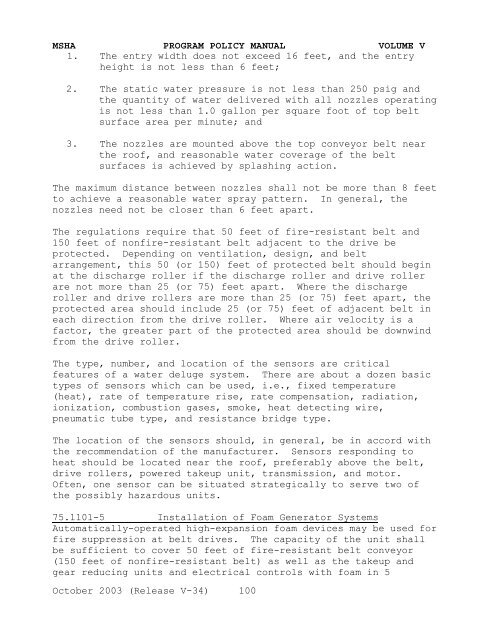Program Policy Manual - VOLUME V - Mine Safety and Health ...
Program Policy Manual - VOLUME V - Mine Safety and Health ...
Program Policy Manual - VOLUME V - Mine Safety and Health ...
Create successful ePaper yourself
Turn your PDF publications into a flip-book with our unique Google optimized e-Paper software.
MSHA PROGRAM POLICY MANUAL <strong>VOLUME</strong> V<br />
1. The entry width does not exceed 16 feet, <strong>and</strong> the entry<br />
height is not less than 6 feet;<br />
2. The static water pressure is not less than 250 psig <strong>and</strong><br />
the quantity of water delivered with all nozzles operating<br />
is not less than 1.0 gallon per square foot of top belt<br />
surface area per minute; <strong>and</strong><br />
3. The nozzles are mounted above the top conveyor belt near<br />
the roof, <strong>and</strong> reasonable water coverage of the belt<br />
surfaces is achieved by splashing action.<br />
The maximum distance between nozzles shall not be more than 8 feet<br />
to achieve a reasonable water spray pattern. In general, the<br />
nozzles need not be closer than 6 feet apart.<br />
The regulations require that 50 feet of fire-resistant belt <strong>and</strong><br />
150 feet of nonfire-resistant belt adjacent to the drive be<br />
protected. Depending on ventilation, design, <strong>and</strong> belt<br />
arrangement, this 50 (or 150) feet of protected belt should begin<br />
at the discharge roller if the discharge roller <strong>and</strong> drive roller<br />
are not more than 25 (or 75) feet apart. Where the discharge<br />
roller <strong>and</strong> drive rollers are more than 25 (or 75) feet apart, the<br />
protected area should include 25 (or 75) feet of adjacent belt in<br />
each direction from the drive roller. Where air velocity is a<br />
factor, the greater part of the protected area should be downwind<br />
from the drive roller.<br />
The type, number, <strong>and</strong> location of the sensors are critical<br />
features of a water deluge system. There are about a dozen basic<br />
types of sensors which can be used, i.e., fixed temperature<br />
(heat), rate of temperature rise, rate compensation, radiation,<br />
ionization, combustion gases, smoke, heat detecting wire,<br />
pneumatic tube type, <strong>and</strong> resistance bridge type.<br />
The location of the sensors should, in general, be in accord with<br />
the recommendation of the manufacturer. Sensors responding to<br />
heat should be located near the roof, preferably above the belt,<br />
drive rollers, powered takeup unit, transmission, <strong>and</strong> motor.<br />
Often, one sensor can be situated strategically to serve two of<br />
the possibly hazardous units.<br />
75.1101-5 Installation of Foam Generator Systems<br />
Automatically-operated high-expansion foam devices may be used for<br />
fire suppression at belt drives. The capacity of the unit shall<br />
be sufficient to cover 50 feet of fire-resistant belt conveyor<br />
(150 feet of nonfire-resistant belt) as well as the takeup <strong>and</strong><br />
gear reducing units <strong>and</strong> electrical controls with foam in 5<br />
October 2003 (Release V-34) 100
















